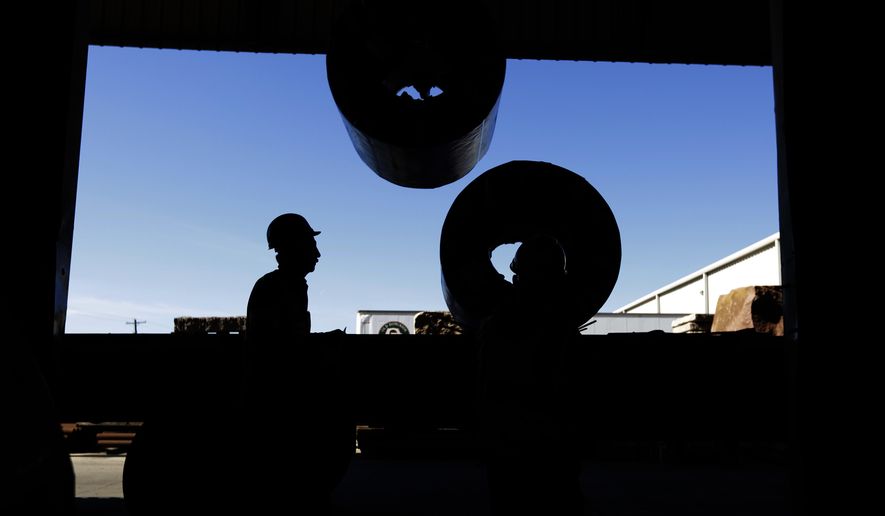President Trump made boosting manufacturing the centerpiece of his economic agenda, vowing to revitalize blue-collar America, but factories just aren’t what they used to be, and the notion of “good-paying” manufacturing jobs that connect high school graduates to the middle class is quickly becoming a myth.
Instead, rank-and-file production workers now lag behind much of the rest of the economy in terms of paychecks, forcing economists to wonder whether the push for more factories is desirable in the first place.
Even the service industry, long dismissed as second-tier employment, averages higher wages than factory laborers, according to a study by the Congressional Research Service that casts doubt on Mr. Trump’s promise of a Rust Belt renaissance.
“The strong middle-class entree that the manufacturing industry offered two generations ago is no longer really there,” said Michael J. Hicks, an economics professor at Ball State University in Muncie, Indiana.
“Manufacturing jobs are increasingly bifurcated,” said Mr. Hicks, who wasn’t involved in the study. “For well-educated people, they are good-paying jobs, and for poorly educated people, they are fairly poor-paying jobs.”
In 2000, the average Joe on the factory floor earned 5.1 percent more on an hourly basis than workers in the services sector, which includes restaurants, sales and plumbing. By last year, factory workers earned 4.3 percent less on average than service workers, according to the report.
Manufacturing wages also trail other industries. Manufacturing workers who aren’t in management pocketed an average hourly wage of $21.54 last year compared with $25.97 for construction workers and $37.12 for workers in the electric utility industry.
Among other findings of the study:
• Despite a 21 percent rise in manufacturing output since a low point in 2009, the accompanying increase in employment was 6 percent.
• Production of goods is no longer the principal occupation of workers in the manufacturing sector, with only 2 in 5 manufacturing employees directly involved in making products.
• Nearly a third — 32 percent — of all manufacturing workers are employed in management and professional jobs that typically require education beyond high school.
Mr. Trump championed manufacturing during his presidential campaign as part of his appeal to Rust Belt voters, who swung the election his way in longtime blue states such as Pennsylvania, Ohio and Michigan.
As president, he moved swiftly to make good on promises to those blue-collar workers.
He pulled out of a massive trade deal with Pacific Rim countries, set up a renegotiation of the North American Free Trade Agreement, established the Office of Trade and Manufacturing and signed a flurry of executive orders to crack down on unfair imports.
“Thousands of factories have been stolen from our country, but these voiceless Americans now have a voice in the White House. Under my administration, the theft of American prosperity will end,” Mr. Trump declared when launching anti-dumping measures.
Charlie Gerow, a Republican political consultant based in Harrisburg, Pennsylvania, said the economic benefits from increased manufacturing, even if not directly from factory jobs, would ripple across the Rust Belt.
“When you look at all the ancillary employment that manufacturing produces with suppliers and technologies that are necessary to run a modern manufacturing plant, that’s where the benefit is to Pennsylvania,” he said.
“There are going to be jobs there. That’s where the president’s promises are going to be fulfilled,” Mr. Gerow said.
The “bad trade deals” targeted by Mr. Trump are responsible for many factory jobs moving to lower-wage countries. But other forces in the U.S., such as automation and shifts in consumer demand, also are contributing to the decline in manufacturing employment.
In the steel industry, which Mr. Trump has made a pet cause, technological improvements have vastly increased labor productivity. The result is a much smaller workforce.
The 84,000 people working in the industry last year produced 3 percent more steel than nearly 400,000 workers did in 1980, according to the CRS report.
An early success for Mr. Trump was persuading Carrier to ditch plans to move its air conditioner factory to Mexico and instead keep it in Indianapolis, saving about 1,000 jobs.
But those assembly line jobs aren’t safe for long. The company invested more than $20 million to automate the plant.
“If you peer beneath the veil of the Carrier experience, you see exactly the dynamic that is playing out,” said Mr. Hicks, the Ball State University economist.
“Those workers were very overpriced. Those were workers making $20 or $24 per hour,” he said. “If you built a new factory in the United States to do what Carrier was doing, they would have been $12- or $13-an-hour jobs. Let’s be honest. If you are assembling a 1950s technology, you don’t need somebody who has a bachelor’s degree or a high school degree.”
Robots increasingly replace large numbers of low-skilled workers. Factories now have fewer workers, and many of those employees have advanced training or college degrees needed to operate, maintain or supervise automated production.
“I would be surprised if 2017 wasn’t a record year [for U.S. manufacturing]. But that’s not going to be accompanied by employment growth,” Mr. Hicks said.
“Places like Muncie or Terre Haute or Steubenville, Ohio, or Waukesha, Wisconsin, aren’t going to be places that experience dramatic reversals of fortune no matter what happens to the manufacturing sectors.”
• S.A. Miller can be reached at smiller@washingtontimes.com.




Please read our comment policy before commenting.